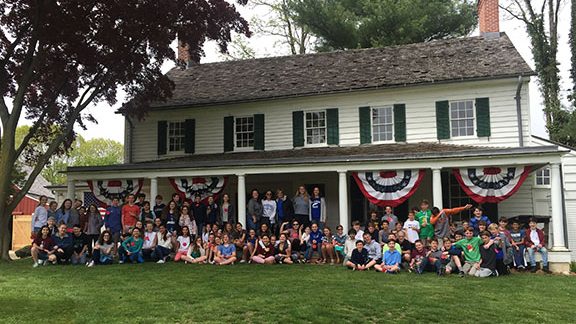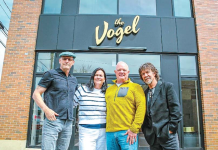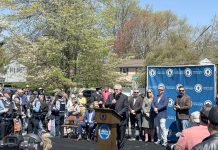
By Melissa Ziobro and Richard Veit
LITTLE SILVER – The Parker Homestead in Little Silver is one of the oldest structures in the state of New Jersey, but its trustees want the community to know they are focused as much on the future as they are on the past.
In the coming weeks, the Homestead will open its doors to the public for tours of its newly restored second floor for the first time, welcome students from grade school through graduate school, kick off its annual lecture series, host a “Toast to Little Silver” in honor of the 100th anniversary of Little Silver’s incorporation as a borough, and so much more.
In 1665, brothers Joseph and Peter Parker moved to New Jersey from Rhode Island and purchased neighboring properties of 240 and 180 acres, spanning the peninsula between the Navesink and Shrewsbury Rivers in what was then Shrewsbury Township.
There is some debate as to which Parker originally owned the area where the current Parker Homestead stands. Local historian Samuel Stelle Smith argued that the property belonged to Joseph Parker. However, research by Julia Parker, the last Parker to reside in the house in the 1990s, claimed that the earliest portions of the house had been built by Peter Parker in the 1660s, with an addition built in 1702.
This 1660s date was contradicted by a tree-ring dating study by Alice Gerard and Richard Veit, Ph.D., Monmouth University professor of anthropology and associate dean of the School of Humanities and Social Sciences, which revealed that the earliest timbers in the current structure were cut in 1721. It is highly possible that the current circa 1721 structure sits on or near the site of an earlier dwelling, which could help explain the discrepancy. The construction of the hearth in the current house shows signs it may have belonged to an earlier structure.
Parkers were certainly at the current Homestead during the Revolutionary War period. The family, as Quakers, were technically neutral. As historians like Michael Adelberg have noted, though, it would have been difficult to stay completely out of the fray. One Parker, William “Boatman Billy,” is believed to have lived as a refugee for some time after refusing to join the Revolutionary forces. However, he is also credited with saving the life of Richard Howell, a Patriot and future governor of New Jersey who was nearly apprehended by a party of Loyalists at the Homestead, and with extinguishing a fire lit by American soldiers in an attempt to raze Christ Church in Shrewsbury.
After the Revolution, the record becomes a bit clearer. William’s son Michael next acquired the farm. He and his wife Ann were among the first in the area to convert to Methodism. Methodist meetings were held at their house in the 1820s. In 1822, Michael Parker donated a lot carved across from the Homestead for the town’s first Methodist church. Upon Michael and Anne’s death in 1854, their son Jacob Corlies Parker, a merchant, had the farm. He died shortly thereafter, in 1855. His widow Julia continued to operate the farm. She converted to the Episcopalian faith and, in the 1860s and 1870s, began to take in boarders.
Her son Michael would inherit the house and extensively renovate and expand it.
During the late 19th century, summer boarders were common and the farm was even used for hunts by Peter Collier, editor of Collier’s Weekly. Michael died in 1911 and his wife Susan inherited the property. During the First World War, wives of some of the officers from nearby Fort Monmouth stayed at the farm. Following Susan’s death in 1943, Julia Parker and her five brothers inherited the property.
As her brothers passed away, they left their shares of the farm to Julia and, on Dec. 16, 1994, Julia conveyed the remaining property to the Borough of Little Silver with the stipulation that she could stay there until her death. She hoped the building might be acquired by the National Trust for Historic Preservation or otherwise used for “charitable, public non-profit historical uses and purposes.” When Julia died in 1995, she was 96 years old.
After Julia’s passing followed a period of sorting through the house’s contents, verifying its history, and readying it for use by the public. This included archaeological investigations led by Veit as early as 1997.
After much painstaking research, the Parker Homestead-1665 was listed on the National Register of Historic Places in 2011 for local significance in the areas of exploration/settlement and agriculture, and as an example of rural vernacular architecture.
Then, in 2012, a great leap forward in Julia Parker’s vision occurred when the Parker Homestead-1665 was established. This 501(c)3 organization, governed by a volunteer board of trustees, collaborates with the Borough of Little Silver “to preserve the unique 330 year history of the Parker Family through the restoration and maintenance of the Homestead lands and buildings and promote their use for educational, historical and cultural exhibits and events dedicated to enriching and increasing our knowledge and appreciation of local heritage.”
Today, the Parker Homestead-1665 group stewards roughly 10 acres, including the Homestead with its enormous cooking hearth, traces of a former bake oven, patterned brickwork fireplace, and a massive stone chimney arch in the basement of the 18th century addition. The house is accompanied by a range of outbuildings, including a well, two barns, a carriage house and a rare restored sweet potato frame.
Though the house, its contents and its grounds are a historic treasure, the board of trustees loves nothing more than to see the site teeming with guests of all ages – not just from Little Silver, but from throughout Monmouth County and beyond. If you have not visited yet, an excellent opportunity to do is fast approaching from 2 to 4 p.m. Sunday, March 19, with “A Toast to Little Silver.” This event celebrates 100 years since Little Silver was incorporated as a borough by an act of the New Jersey Legislature from portions of Shrewsbury Township. “There’s no better place to celebrate this milestone than at the Homestead,” said Keith B. Wells, Parker Homestead-1665 board of trustees president.
The event will feature a variety of activities, including an opening ceremony led by local Scouts, musicians, Little Silver’s mayor and other dignitaries, a toast and other refreshments, live music, an art display, an antique car show, and much more. The second floor of the historic home will be open to the general public for tours for the first time. This event is free and open to all.
Roughly 300 years after the oldest portions of the current home were built, there’s still always something new happening at the Parker Homestead. For all the latest news, visit parkerhomestead1665.org.
Melissa Ziobro is the specialist professor of public history at Monmouth University’s Department of History and Anthropology. She is a former trustee of the Parker Homestead. Richard Veit, Ph.D., is associate dean of the School of Humanities and Social Sciences at Monmouth University.
Parker Homestead-1665 trustees Keith Wells and Stephanie DeLaat contributed to this article.
The article originally appeared in the March 9 – 15, 2023 print edition of The Two River Times.














